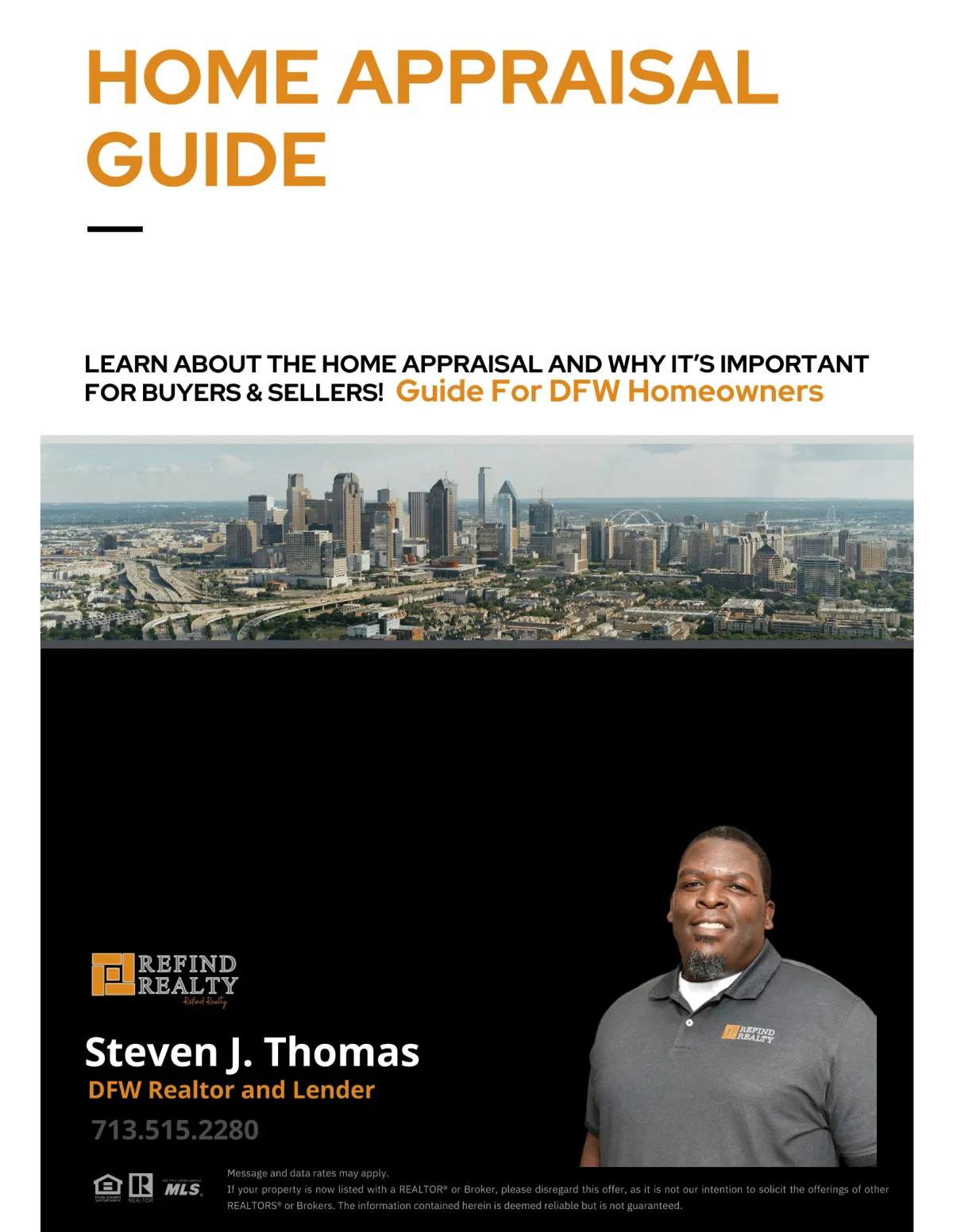You're Always At Home With Refind Realty.
Serving Your DFW Real Estate Needs Since 2005.
We Help You Buy and Sell in The Greater Dallas-Fort Worth Area.
Check Out Our Social Media Channels!
Buying in DFW
Buying your first or next home should be a rewarding and exciting time in your life, and one that you look back on with fond memories.
Thinking Of selling?
The market has changed a lot and I'd love to show you the exact strategy I use to get sellers in DFW top dollar for their property.
Get Pre-Approved
Let me walk you through the entire pre-approval process so you know exactly how much home you can afford.
Sign Up For my
Email List
My emails are a great way to stay up-to-date with local news and real estate market trends, even if you're not currently in the market. So, come on and join me to stay in the loop!
affordability Calculator
Get pre-approved to know exactly how much house you can afford. Use this calculator to get a quick estimate. Contact me for assistance!
DFW New Construction
Discover the latest new home constructions in DFW and take advantage of the builder incentives that are available now.


Owned and Operated by Thomas & Thomas Financial Group, LLC
Let's Make Your real estate Dreams Come True.
Newest Listings
Call Me Today At (713) 505-2280

Refind Realty Blog:


How to Sell a Dallas Home That Needs Repairs | Refind Realty DFW
How to Sell a Home in Dallas That Has Needed Repairs (What to Disclose & How to Market It)

Direct Answer
You can sell a home in Dallas even if it needs repairs — and many sellers do.
The key is knowing what to disclose, how to price, and how to market the home strategically so that buyers see value instead of problems.
In DFW’s competitive market, you don’t have to fix everything. You just need a plan that protects your liability, attracts the right buyers, and positions your home clearly.
1. What You MUST Disclose in Texas
Texas law requires you to provide a Seller’s Disclosure Notice outlining the condition of major systems and any known issues.
Required disclosures include:
Roof leaks or previous roof repairs
Foundation cracks or movement
Plumbing or HVAC issues
Electrical problems
Water damage or mold
Termite activity or past treatments
Flooding or drainage issues
Any repairs that were started but not completed
💡 Rule of Thumb: If you know about it, disclose it.
Transparency reduces lawsuits and builds buyer trust, especially when repairs are visible.
📄 Tip: Pre-fill the TX Seller’s Disclosure Notice before listing. It shows buyers you’re serious and upfront.
2. Decide Whether to Fix, Partial-Fix, or Sell As-Is
You do NOT need to repair everything. In fact, some repairs cost more than they return.
Option A — Make Key Repairs (Recommended)
Fix high-impact, low-cost items:
Paint & touch-ups
Carpet cleaning or replacement
Minor plumbing leaks
Light fixtures & hardware
Landscape cleanup
These small changes significantly improve buyer perception.
Option B — Partial Fix + Credit
If big repairs are needed (roof, HVAC, foundation), you can:
Provide a repair estimate
Offer a closing credit
Price accordingly
This is attractive to buyers who want flexibility.
Option C — Sell As-Is
Perfect for:
Investor buyers
Cash buyers
Situations where repairs are too expensive
Use phrases like:
“Priced according to condition — great opportunity in established neighborhood.”
Notably, as-is still requires full disclosure in Texas.
3. How to Market a Home That Needs Repairs
Homes with imperfections can still shine with the right strategy.
Highlight the strengths
Lot size
Location
School district
Floor plan
Newer mechanicals
Energy-efficient features
Use professional photography
Even “fixer” homes deserve premium marketing.
Bright photos make the home feel livable, not distressed.
Tell the story clearly
Instead of hiding flaws, frame the opportunity.
Examples:
“Great chance to customize a well-loved DeSoto home.”
“Cosmetic updates needed — major systems already in good condition.”
“Investor-ready home close to I-35E and shopping.”
Target the right buyer pool
First-time buyers looking for value
Cash buyers
Investors
Buyers moving from apartments seeking a starter home
🎥 Pro Tip: Add a pre-listing video walkthrough to show layout and potential.
4. Pricing Strategy for Homes Needing Repairs
Pricing wrong is the #1 reason repair-needed homes sit on the market.
Use this formula:
Market Value (after repairs)
– Estimated Repair Costs
– Convenience Discount (3–5%)
= Smart, competitive list price
Buyers will pay more for transparency and accuracy.
📊 Get a data-backed valuation: Home Seller Score
5. Use Pre-Inspections to Strengthen Buyer Confidence
A pre-listing inspection helps you:
Know what buyers will discover
Control the narrative
Reduce repair demands
Attract more confident offers
You can also share:
Contractor estimates
Roof or foundation engineer reports
HVAC service history
This builds trust and speeds up negotiations.
6. Programs That Help You Sell With Repairs Needed
If you don’t want to fix anything or deal with contractors:
SureSale (Pre-Inspected + Cash-Backed Offer Program)
Helps sellers market the home with confidence and attract stronger buyers.
HomeSwap Program
Buy your next home first using equity access — then sell your current home after moving out.
Sell & Stay
Close now and lease the home back while prepping your next move.
Explore all options → Home Selling Options
7. How I Market Repair-Needed Homes at Refind Realty DFW
As both a Broker and Loan Officer, I structure listings to reduce friction for buyers and maximize your profit:
Pre-listing evaluation
Repair ROI analysis
Disclosure assistance
Professional media
Targeted digital ads
Net sheet comparison
Negotiation for credits instead of repairs
Most sellers are surprised at how well a repair-needed home performs with the right positioning.
Conclusion
You don’t need a perfect home to sell successfully in Dallas–Fort Worth.
You just need transparency, smart pricing, and a marketing plan that highlights value over flaws.
With the right strategy, you can sell confidently — even if your home needs work — and transition smoothly into your next home or new construction build.
📈 Get Your Home Seller Score
📘 Download the Home Seller Checklist
📅 Book Your Home Goals Consultation
Key Takeaways
You must disclose known defects — transparency protects you legally.
You can fix, partial-fix, or sell as-is depending on ROI.
Good marketing helps buyers see potential, not problems.
Pricing should balance repair costs and market value.
Programs like HomeSwap or SureSale help sellers avoid stress.
Repair-needed homes can still attract strong offers with proper positioning.
Custom HTML/CSS/JAVASCRIPT
Stay Informed With My Downloadable
Buyer and Seller guides

6 Smart Ways to Build Home Equity

7 Insider Secrets To Selling Your Home w/o a Lot of Time or Money

DFW Home Seller Negotiation Secrets

Home Appraisals Guide

Avoiding Pitfalls That Can Derail Your Home's Sale

Ultimate Guide To Buying a Home

A First Time Homebuyers Guide In DFW

Are You Ready To Buy?

25 Insider Secrets To Buying A Home

How to Improve Your Credit
Download All My Guides For Free


Owned and Operated by Thomas & Thomas Financial Group, LLC
Steven J. Thomas
Steven J. Thomas has been in the financial services industry for the past 19 years and started my career as a Financial Planner for American Express Financial Advisors. I entered into banking with JP Morgan Chase as personal banker in 2003 and was promoted several times up to Small Business Specialist. I earned multiple Million Dollar Club awards and was ranked in the top 5 Small Business Specialist before I branched out in 2005 to start my own Financial Management Company. I ran a successful company before family circumstances lead me to Wachovia Bank in 2008 where I worked as a Senior Financial Specialist. As a Sr. Financial Specialist; I was responsible for the P & L and revenue growth of my banking center. The elimination of my role thru a bank merger lead me to BBVA Compass. I have held various leadership roles at BBVA Compass including Personal Relationship Manager, Branch Retail Executive, Workplace Solutions VP, and his current role as a Retail Manager. As the Regional Workplace Solutions VP, I was responsible for the strategic, tactical, and execution of Partnership Banking relationships, promotion and activity with corporate and non-profit companies in my footprint. I was responsible for the acquisition production for three districts, which includes 51 banking centers and over 300 employees. In May of 2014, I joined the team at Refind Realty and became one of the managing partners in mid-2015.

Wondering What Your DFW Home Could Be Worth in 2025?
Get a Professional Home Valuation From A Local Market Expert
Unlock insights into potential selling prices.
Get a personalized analysis sent directly to your inbox.
Stay ahead with updates on property value fluctuations.
Benchmark your property against neighborhood listings.
Get a FREE Home Valuation And Potential Net Sheet:


I used this realtor and it was a great experience. He was patient and very helpful with our journey. He also helped us find a great lender with little hassle on the process, also got us approved for well above the market of our original home so we were able to get more house with a lower mortgage rate. So to anyone who is interested in buying a home take my advice give Steven a call. It’s worth it 😁
Bryant Loring


Steve was absolutely amazing! Everything was easy! Very professional in all aspects. Punctual, responsive, and diligent. He goes above and beyond to ensure you get to see as many homes as you’d like no matter the location. Not only was he knowledgeable about home buying, he also has a resourceful network for new home owner needs. I recommend Refind Realty to everyone!
Nicholas Bishop


I definitely recommend Steven to assist with your home buying needs. As a first time home buyer the process can be overwhelming, but as my realtor he was knowledgeable & patient while addressing my concerns and assisting me with my new home purchase. Thanks again Steven!! :-)
Gayle Mason

Ask Us Anything
Frequently Asked Questions
Why do you need a Realtor?
When buying or selling a home, there are so many options…which can also present a lot of obstacles. Laws change, forms change, and practices change all the time in the real estate industry. Because it’s our job to stay on top of those things, hiring a realtor reduces risk, and can also save you a lot of money in the long run.
When you work with me as your Realtor, you’re getting an expert who knows the area; knows how to skillfully guide your experience as a seller or buyer; can easily spot the difference between a good deal and a great deal. My job is to translate your dream into a real estate reality, and I work hard to earn and keep my business. This also means earning your trust: When you work with me, you’ll be working with a realtor who looks out for your best interests and is invested in your goals.
Which loan should you choose?
There are two different types of loans conventional loans and government-backed loans. The main difference is who insures these loans:
1 - Government-backed loans (FHA, VA and USDA):
(a) - Are, unsurprisingly, backed by the government.
(b) - Include FHA loans, VA loans, and USDA loans.
(c) - Make up less than 40 percent of the home loans generated in the U.S. each year.
2 - Conventional loans
(a) - Are not backed by the government.
(b) - Include conforming and non-conforming loans (such as jumbo loans).
(c) - Make up more than 60 percent of the loans generated in the U.S. each year.
What is the difference between FHA, VA and USDA loans?
1 - FHA LOANS:
FHA loans, which are insured by the Federal Housing Administration, are typically designed to meet the needs of first-time homebuyers with low or moderate incomes. FHA loans can be approved with a down payment of as little as 3.5 percent and a credit score as low as 580.
FHA loans are often called “helper loans,” because they give a leg up to potential borrowers who may not be able to secure one otherwise. For this reason, FHA loans have maximum lending limits, which are determined based on housing values for the county where the for-sale home is located.
Because the agency is taking on more risk by insuring FHA loans, the borrower is expected to pay mortgage insurance both at the time of closing and on a monthly basis, and the property must be owner-occupied.
2 - VA LOANS:
VA loans are backed by the Department of Veterans Affairs and they are guaranteed to qualified veterans and active-duty personnel and their spouses. VA loans can be approved with 100 percent financing, meaning VA borrowers are not required to make a down payment.
Unlike FHA loans, borrowers do not have to pay mortgage insurance on VA loans.
3 - USDA LOANS:
You may also hear about USDA loans, which are backed by the United States Department of Agriculture mortgage program. USDA loans are intended to support homeowners who purchase homes in rural and some suburban areas. USDA loans do not require a down payment and may offer lower interest rates; borrowers may have to pay a small mortgage insurance premium in order to offset the lender’s risk.
What’s a conventional loan? Understanding what it means to be conforming and non-conforming
Buyers who have a more established credit history and a larger down payment may prefer to apply for a conventional loan. These loans may offer a lower interest rate and only require the home buyer to purchase monthly mortgage insurance while the loan-to-value ratio is above a certain percentage, so a conventional loan borrower can typically save money in the long run.
Conventional loans are divided into two types: Conforming loans and non-conforming loans.
1 - CONFORMING LOANS:
Conforming loans are those that meet (or conform to) predetermined standards set by Fannie Mae and Freddie Mac — two government-sponsored institutions that buy and sell mortgages on the secondary market. By selling the loans to "Fannie and Freddie," lenders can free up their capital and return to issue more mortgages than if they had to personally back every loan that they approve.
The main standard for conforming loans is that the amount borrowed must be under a certain amount; in Alaska, a single-family home loan must be under $647,200 in order to be considered conforming.
Properties with more than one unit have higher limits.
2 - NON-CONFORMING (JUMBO) LOANS:
But what happens if a borrower wants to borrow more than the Freddie- and Fannie-approved loan amount? In this case, they would have to apply for a “jumbo loan,” which is the most common type of non-conforming loan.
Because the lender cannot resell the jumbo loan (or any non-conforming loan) to Freddie Mac or Fannie Mae, jumbo loans are considered to be riskier than a conforming loan. To protect against this risk, the bank will typically require a higher down payment; the interest rate on a jumbo loan may also be higher than if the same borrower applied for a conforming loan.
What kind of rate should you choose?
Rate types: Fixed-rate vs. adjustable-rate mortgages.
In addition to the loan type you choose, you’ll also have to determine if you want a fixed-rate mortgage or an adjustable-rate mortgage (ARM). A fixed-rate mortgage has an interest rate that does not change for the life of the loan, so it provides predictable monthly payments of principal and interest.
An adjustable-rate mortgage typically offers an initial introductory period with a low-interest rate. Once this period is over, the interest rate adjusts periodically, based on the market index. The initial interest rate on an ARM can sometimes be locked in for different periods, such as one, three, five, seven, or 10 years. Once the introductory period is over, the interest rate typically readjusts annually.
Office 1229 E. Pleasant Run Ste 224, DeSoto TX 75115
Call :(713) 505-2280
Email: [email protected]
Site: www.stevenjthomas.com

Facebook
Instagram
X
LinkedIn
Youtube
TikTok